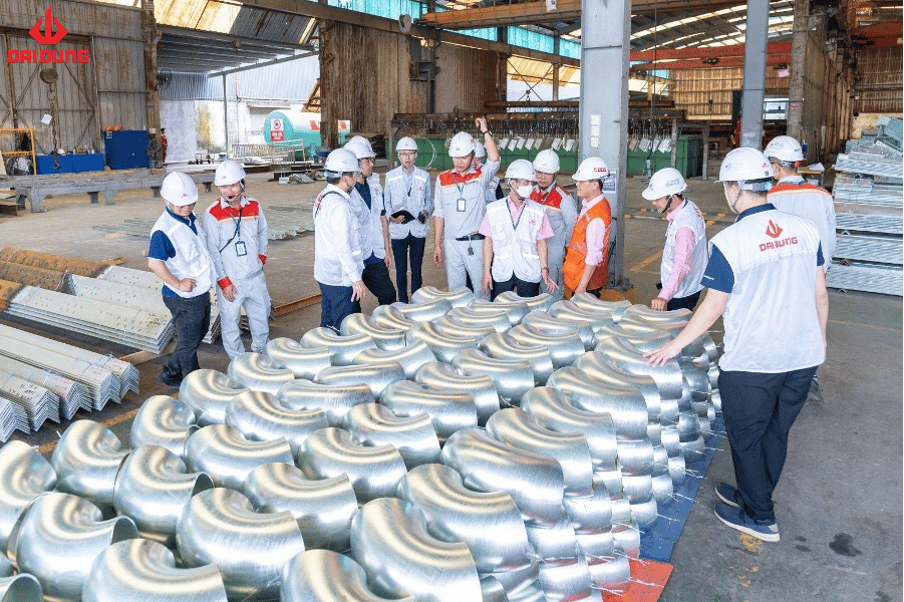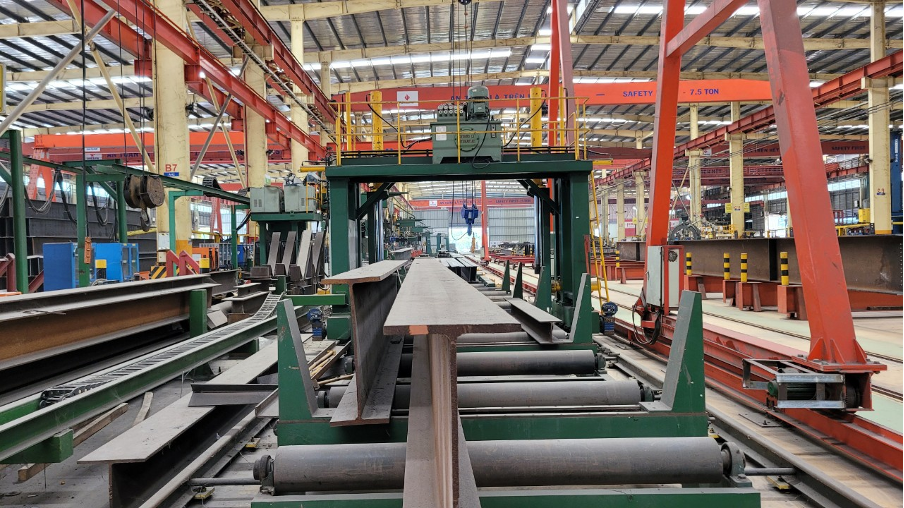Hot dip galvanized steel is one of the most effective metal protection solutions available today, particularly favored in heavy industrial and civil construction projects. This process creates a durable zinc coating that helps steel resist corrosion, extend its service life, and maintain its mechanical properties.
Notably, this type of steel stands out for its fire resistance, as it does not produce toxic smoke when burned, can withstand high impacts, and effectively protects internal components when used as a protective material. Join DaiDung Group (DDC Group) to explore this topic in more detail in this article.

What is Hot Dip Galvanized Steel?
Hot-dip galvanized steel is a steel product (usually carbon steel) that has undergone a surface treatment where it is coated with a protective layer of zinc. This is achieved by immersing the entire steel object into a bath of molten zinc heated to a high temperature (typically around 450°C).
This process creates a zinc coating that is metallurgically bonded to the base steel surface. This coating has a multi-layered structure consisting of iron-zinc alloy layers with progressively increasing hardness, topped by an outer layer of pure zinc.
The primary purpose of hot-dip galvanizing is to protect steel from corrosion and rust when exposed to the environment, especially in outdoor applications or humid conditions. The zinc layer acts as a physical barrier, separating the steel from the environment, while also providing cathodic protection. This means that if the coating is scratched, the zinc will corrode preferentially to the steel.
Thanks to its superior corrosion resistance, hot-dip galvanized steel significantly extends the lifespan of steel structures and products. It is widely used in industries such as construction (factory structures, bridges, railings), transportation infrastructure (lamp posts, signs), energy, and agriculture. National standards (such as TCVN issued by government agencies) and international standards often specify the technical requirements for hot-dip galvanized coatings to ensure quality and protective effectiveness.
International and Vietnamese Standards for Hot-Dip Galvanized Steel
To ensure the quality and effectiveness of the hot-dip galvanized coating, numerous international and national standards have been established. These standards regulate requirements for the manufacturing process, coating quality (thickness, adhesion, appearance), and testing and evaluation methods.
Some common international standards include:
- British Standards (BS): Established by the British Standards Institute (BSI), these include BS 31:1940 and BS 4568:1970 for steel conduits for electrical wiring. Notably, BS 4568:1970 is divided into Class 3 (pre-galvanized steel) and Class 4 (hot-dip galvanized steel) with different technical requirements.
- European Norm (EN): BS EN 61386-21:2004 is the British standard version harmonized with European standards, with a structure and function equivalent to BS 4568:1970 Class 4.
- Japanese Industrial Standards (JIS): This is one of the standards applied in the production of galvanized steel pipes, reflecting the technological advancement of galvanizing in a leading industrial nation.
- American National Standards (ANSI/UL): This standard from the American National Standards Institute/Underwriters Laboratories is widely applied in the US and many other countries, especially for steel conduits and galvanized steel products used in construction.
- International Electrotechnical Commission (IEC): This standard applies to products in the electrical field, including galvanized steel conduits.
In Vietnam, the current national standards (TCVN) for hot-dip galvanizing include:
- TCVN 5408:2007 (ISO 01461:1999): Specifies requirements and test methods for hot-dip galvanized coatings on iron and steel articles.
- TCVN 10355:2018 (ISO 3575:2016): Applies to continuous hot-dip zinc-coated and zinc-iron alloy-coated carbon steel sheet of commercial and drawing qualities.
- TCVN 6525:2018 (ISO 4998:2014): Specifies requirements for continuous hot-dip zinc-coated and zinc-iron alloy-coated carbon steel sheet of structural quality.
- TCVN 11374:2016 (ISO 9364:2011): Applies to continuous hot-dip 55% aluminum/zinc alloy coated steel sheet of commercial, drawing, and structural qualities.
Specialized Terms for Hot Dip Galvanized Steel
Hot-dip galvanizing is a common process to protect steel from corrosion. The standard TCVN 6525:2008 specifies the technical requirements for continuous hot-dip zinc-coated carbon steel sheet of structural quality. To better understand this process, we need to grasp the following basic terms:
- Continuous hot-dip zinc-coated steel sheet: A product created by immersing cleaned (descaled) hot-rolled or cold-rolled steel coils into a molten zinc bath on a continuous production line.
- Normal coating: This coating is formed by the unrestricted growth of zinc crystals during the normal solidification process. It has an average coating thickness suitable for general applications like construction, roofing, and metal fabrication.
- Minimized spangle coating: A coating created by restricting the formation of normal zinc crystals (spangles) during the solidification process, resulting in a smoother, more aesthetic surface. It is suitable for applications requiring a high aesthetic finish, such as interior decoration and home appliances.
- Smooth finish: A smooth, glossy coating formed by cold-rolling the coated material after normal galvanizing. This enhances the surface’s brightness, smoothness, and resistance to scratching and dust.
- Zinc-iron alloy coating: A coating formed by treating the zinc-coated steel sheet so that the coating on the base metal becomes a zinc-iron alloy. It offers higher corrosion resistance than normal zinc coating and has self-healing properties for minor scratches.
- Differential coating: A zinc coating with different thicknesses on the two sides of the steel sheet. This is suitable for applications requiring different coating thicknesses, such as roofing where the underside needs more corrosion protection.
- Skin pass: A light cold-rolling process applied to the galvanized steel sheet to improve flatness, smoothness, and minimize surface defects, enhancing the aesthetic and surface quality.
- Coating mass: The amount of zinc applied to the steel surface, typically measured in g/m².
- Coating adhesion: The ability of the zinc coating to firmly adhere to the steel surface, tested using a bend test.
- Weldability: The ability of the hot-dip galvanized steel sheet to be welded. It can be welded, but appropriate welding conditions must be selected.
- Surface treatment: Methods applied to the surface, including passivation, phosphating, and oiling.
- Coating and base metal thickness:
- Coating thickness is the thickness of the zinc layer applied to the steel.
- Base metal thickness is the thickness of the steel sheet before coating.
- Coating designation: The standards use codes to denote the coating type, mass, condition, and other information. For example, Z designates a zinc coating, and ZF designates a zinc-iron alloy coating. The following numbers (e.g., 100, 180, 200) indicate the coating mass.

Understanding these terms provides a more comprehensive and accurate overview of the hot-dip galvanizing process and the technical requirements for its products.
In Vietnam, the galvanized steel industry is growing, with notable projects like the Thai Nguyen galvanized steel pole factory. Amid this strong development, DaiDung Group is proud to affirm its pioneering position as a leading manufacturer and supplier of high-quality galvanized steel products. We not only master advanced technology but also directly manufacture and supply a diverse range of galvanized steel solutions to meet the market’s strictest demands.
Galvanized steel products bearing the DDC Group brand are manufactured and rigorously controlled according to prestigious international quality standards such as BS, ANSI/UL, and JIS. In parallel, DaiDung Group demonstrates a strong commitment to sustainable development, being one of the first enterprises in the steel structure industry to have its greenhouse gas emissions inventory for factory operations and products officially verified by the British Standards Institution (BSI) as conforming to international standards ISO 14064-1:2018 and ISO 14067:2018.
By proactively managing the entire process from production and strict quality control to fulfilling our environmental responsibilities DDC Group is committed to delivering products that not only excel in durability but also meet the stringent green standards of the global market, particularly in the EU and the United States. This confirms our status as a reputable and responsible Vietnamese brand.
